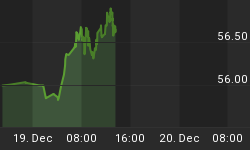If one pays attention to the official US economic data releases, it is easy for one to make the argument that inflation is on the wane. Over the past few months, inflation - as measured by CPI or PPI, headline or core have all been converging or dipping below the zero level. And that of course is good for bonds, right??? Wrong! Bonds have been fading for the past 3 weeks and look to test key support at 4.20% on the 10 year Treasury note. With investors somewhat less bullish by certain measures, Central Banks lacking motivation to buy due to a stronger dollar, the Fed still in tightening mode, the bond market does not look nearly as attractive as it did when rates in the long end of the yield curve were 450 basis points higher than the Fed Funds rate. At the moment the economy appears to be in top shape, Master Al will most likely reiterate that notion at his semi-annual testimony in front of the House and senate. Right or wrong, I do not expect his remarks to be supportive for the bond market.
NOTEWORTHY: The economic calendar was not only busy, but also mostly positive. In addition to the low inflation news mentioned above, most indicators beat expectations. Retail sales were stronger than forecast, the Trade Deficit has shrunk again, and it was lower than expectations, surveys both on the manufacturing and consumer fronts continue to outpace consensus. Even Capacity Utilization managed to climb higher than economist forecasts, and it finally managed to hit the 80% level well into the third year of the recovery. Looks to me like last week's numbers are suggesting that the US economy is growing at a solid pace with low or mostly no inflation to be concerned with in the near term. Next week's highlight will be Master Al's economic report on Wednesday and Thursday. The rest of the schedule includes some minor data on the housing front, more surveys and a smattering of the usual weekly reports. On the equity side, reporting season is upon us. News and stock market reaction on this front will have an impact on rates.
INFLUENCES: While some surveys and headlines are indicating that the experts in the fixed income arena are becoming somewhat less negative on the market, portfolio managers participating in the JP Morgan survey suggest that there are plenty of bears left out there - something like 52% of participants -, while not many bulls - 5% is definitely not an overwhelming number. The 'smart money' commercials are long 154k contracts (a solid increase from last week's 93k). This number is becoming slightly positive again for bonds. Seasonals are neutral and choppy in July. Bonds continue to give up ground and look set to test - and perhaps break some key levels next week. On the technical front, bonds still have a positive bias, but they need to hold above 116-00 on the Long Bond Futures to retain a positive spin.
RATES: US Long Bond futures closed at 116-13, down almost another half a dollar this week, while the yield on the US 10-year note increased 7 basis points to 4.17%. 10 year notes broke first support at 4.14% and need to stay below 4.20% - which is incidentally the 200 day moving average - in order to retain a positive bias. The Canada - US 10 year spread was 5 wider to -25 basis points in spite of some tough talk from the Bank of Canada talking heads last week. We are officially neutral on this spread at this point. It does not seem to matter whether yields are going up or down, the belly of the Canadian curve continues to outperform the wings. Selling Canada 3.25% 12/2006 and Canada 5.75% 6/2033 to buy Canada 5.25% 6/2012 was at a pick-up of 35 basis points, an improvement of 3 basis points for the middle part of the yield curve. Assuming an unchanged curve, considering a 3-month time horizon, the total return (including roll-down) for the Canada bond maturing in 2013 is the best value on the curve. The inflection point on the Canadian yield curve is moving out. During the past 6 months the best value maturity date has alternated between the 2011 and 2012 issues, now this point has shifted further out to the 2013 area. Bond market participants not only in the Canadian government bond market, but also in provincial and corporate issues are advised to shift the focus of their investments accordingly. In the long end, the Canada 8% bonds maturing on June 1, 2023 continue to be cheap on a relative basis.
CORPORATES: Corporate bond spreads were very well supported last week. Long TransCanada Pipeline bonds were 5 basis points tighter at 116, while long Ontario bonds were in 1 to 45.0. A starter short in TRAPs was recommended at 102 in February 2004. Corporates have been narrowing for the past few weeks, but I believe they are close to ending this trend. Shorter maturity, quality corporates should be favoured over lower rated issues as I believe corporate spreads will continue to be under pressure. Any credit that is connected with the consumer and discretionary spending should be avoided. As a new recommendation we advised to sell 10 year Canadian Bank sub-debt at a spread of 58 bps over the 10 year Canada bond. This spread closed at 52 basis points last week. Obviously we were early selling, but we will hold this position for the time being.
BOTTOM LINE: Neutral continues to be the operative word on bonds. An overweight position in the belly of the curve is still recommended for Canadian accounts. The inflection point on the Canadian yield curve is shifting from the 2011-2012 bonds to the 2013 maturity area. Short exposure for the corporate sector is advised. We recommended an increase in short corporate exposure last week.















